The Mystery of Skirk’s Name, Element, and Background
Legend describes her as the "Abyss-wandering swordmaster" and the "solitary women dwelling within the cosmos' deepest shadows." Following her fleeting glimpse in Genshin Impact's Version 4.2 storyline, we finally witness the official release of Tartaglia's master, Skirk! Undoubtedly, Travelers have long awaited this enigmatic character. Today, let us delve into the lore intricacies surrounding Skirk!

1. Skirk Character Background Introduction
From the character background introduction, Skirk is a surviving remnant of Khaenri'ah-a girl rescued during the Cataclysm by Surtalogi, the Foul (one of the Five Sinners), though it's possible she was saved either by Dainsleif's brother, "The Visionary" Vedrfolnir, or jointly by two Sinners. Later, under Surtalogi's guardianship and tutelage, Skirk mastered extraordinary martial prowess.
As fate ordained, Skirk would later rescue another child similarly entwined by destiny, becoming his mentor. That child would grow to become the Fatui Harbinger "Childe" Tartaglia. During Fontaine's Prophecy Crisis, Childe confronted the All-Devouring Narwhal bound to his fate-and it was amidst this cataclysm that we witnessed our first encounter with Skirk.
"In the days after the underground civilization collapsed, upon a patch of unremembered, scorched earth-
The one who despised destiny plucked a young girl from the hand of fate.
Once she had grown up, she too saved a child ensnared by providence.
How good it would be if warmth could be the measure of all things, if all tales could end in joy...
Yet the road ahead is uncertain, the sights beyond unknown."
Skirk's character card background stands as the most unique among all playable characters, signifying her origin beyond any of Teyvat's seven nations. In truth, this backdrop does not wholly align with Khaenri'ah either. Comparative analysis with Dainsleif's character card reveals Skirk's background appears as a distorted reflection of Khaenri'ahn motifs-akin to an image fractured in a shattered mirror-while the abyssal starscape within her portrait confirms her knowledge and power "transcend this world."
1.1 Skirk's element: Seven-Shifting Serpent
Notably, though Skirk's element remains "Cryo" within the familiar seven-element system, she bears no Vision. Instead, her power manifests through the newly introduced "Seven-Shifting Serpent" concept. This suggests her abilities may not stem from elemental energy but rather an "extra-worldly force" mimicking Cryo properties or perhaps an alternate elemental manipulation pathway akin to the "Primordial Dragon's Authority." Concrete answers await her official release and accompanying lore revelations.

The serpent motif has manifested twice among known Khaenri'ah-affiliated characters, most notably in Dainsleif's constellation designation, "Snake Ring Constellation." These ophidian references likely correlate with the Ouroboros (Oὐροβóρος), an ancient symbol of infinity depicting a serpent devouring its own tail-a concept explicitly referenced in Enkanomiya through the axiom "Heaven and earth were as an egg; dragons and serpents were ever one." Considering Khaenri'ah's cultural archetypes, the serpent symbolism may also intertwine with Jörmungandr, the World Serpent of Norse mythology.
1.2 Regarding the World Serpent "Jörmungandr"
In Norse mythology, the World Serpent Jörmungandr is the second son born to the trickster god Loki and the giantess Angrboða. Foretold by the Norns (the Fates) that Loki and Angrboða's offspring would bring about Ragnarök, Jörmungandr was cast into the boundless sea encircling Midgard by Odin while still a child. Yet the gods never foresaw that Jörmungandr would grow into a colossal serpent whose body could encircle the entire mortal realm, thus earning the name World Serpent. With its immeasurable bulk, Jörmungandr must bite its own tail to maintain its grip around the world. Legends decree that when it releases its tail, the apocalypse -Ragnarök-shall commence.

2. Skirk – Name Meaning & Origin
Proceeding with an analysis of Skirk's lore, we first examine the etymology of her name, "Skirk." Disregarding minor phonetic discrepancies, the name likely derives from the Old Norse word "Skær" (where "æ" approximates the "i" sound, rendering a pronunciation close to "Skír")-the nominalized form of the adjective "Skærr," meaning "faint glow" or "radiance" (specifically referring to dim light from celestial sources). Aligning with her epithet "Void Star" and Tartaglia's character card description of her as the "solitary maiden dwelling within the cosmos' deepest shadows," the imagery of "starlight shimmering within an abyssal void" indeed serves as a compelling thematic foundation for Skirk's character.
An alternative interpretation posits that the name "Skirk" holds Celtic cultural roots. A town named Skirk exists in Ireland, rendered in Irish as "Scadharc"-a compound of "Scáth" (shadow) and "derc" (mirror). This etymology allows Skirk to be linked with Scáthach, Queen of the Celtic underworld "Dún Scáith" (Fortress of Shadows) in Irish mythology.
Scáthach, a martial goddess revered as the patron of warriors, excels in combat arts and arcane knowledge. Renowned as a mentor who imparts her skills to countless champions, her most legendary disciple is the demigod hero "Cú Chulainn" (Irish: Cú Chulainn)-the Hound of Ulster. The divine spear "Gáe Bolg" (Irish: Gáe Bolg), wielded by Cú Chulainn, was bestowed upon him by Scáthach herself.

In later artistic interpretations, Scáthach is often depicted as a statuesque beauty with a fair complexion, clad in armor and eyes ablaze with fiery intensity-a portrayal that aligns with Skirk's in-game design. This archetypal parallel further resonates with Skirk's narrative of mentoring Childe in martial arts. Notably, Skirk's Japanese voice actor, Mamiko Noto, coincidentally also voices Scáthach in Fate/Grand Order, adding a meta-textual layer to this connection.
Some may question: Given Khaenri'ah's distinct Norse mythological influences, why would Skirk-so deeply tied to Khaenri'ah-draw from Celtic rather than Nordic archetypes? Culturally, Scáthach of Celtic myth and the Norse winter goddess Skaði (Old Norse: Skaði) share mythological roots as "deities embodying shadows." This syncretism inspired Fate/Grand Order to create the composite character "Scáthach-Skadi" (Scáthach ≒ Skaði).
PS: Skirk's master, "The Foul" Surtalogi, derives his name from Surtr's flaming sword in Norse mythology-Lævateinn, the infernal blade destined to immolate all creation.
3. Genshin 5.5 new Artifact Set "Finale of the Deep Galleries" and Skirk
Additionally, the flagship artifact set "Finale of the Deep Galleries" introduced in Version 5.5 holds ties to Skirk. The lore premise of this set recounts Skirk's journey under the guidance of her mentor, "The Foul" Surtalogi (one of Khaenri'ah's Five Sinners), to Hyperborea-a lost northern kingdom buried beneath glacial seas. There, she delved into snow-entombed ruins, uncovering pivotal secrets of Teyvat's history. Notably, Skirk's feathered hair ornament bears a striking resemblance to the set's Plume of Death, "Deep Gallery's Distant Pact."


The lore inscribed within the "Finale of the Deep Galleries" artifact set can be summarized as follows:
In the ancient past when divine edicts still permeated the skies, a celestial traveler-strongly implied to be the "Third Descender"-projected consciousness through Teyvat's celestial "shell," inhabiting the body of a nameless youth from the northern wastes. This traveler originated from an ultra-advanced civilization beyond the stars, having visited Teyvat in primordial times before Phanes' incursion, forging pacts with Nibelung, the Primordial Dragon of the world's essence. This youth later moved the First Seraphim's heart, becoming their consort. Together, they raised the banner of rebellion against the Heavenly Principles within the golden spires of Hyperborea, vowing to liberate mortal kin from absurd celestial decrees and lead them back to the stars.
Yet their defiance ended in ruin. The golden city fell to divine nails within a night. The betraying Seraphim was stripped of name and form, while their entire race suffered the Heavenly Principles' wrath through the merciless edict: "Gaze not upon the sky, love not humankind." Their once-magnificent bodies and intellects withered into hollow shells-the frail "Seelies" now scattered across the land, who still instinctively guide humanity despite their desolation.
At the climax of Fontaine's Archon Quest in Version 4.2, it was Skirk who revealed the bombshell truth: "Visions are crafted from the remains of the Third Descender." Assuming the traveler mentioned in the Deep Gallery set indeed refers to the Third Descender, Skirk's condemnation of Visions as "objects of misfortune" and her cryptic statement-"To live is in itself a blessing. But once a person dies, the bonds he once had with this world shall all turn to curses"-now resonate with profound clarity.

Furthermore, through the "Song of the Welkin Moon" event, we have learned that the "Frostmoon Scions"-destined to emerge as a central faction in the upcoming region Nod-Krai-are the legendary scions of the golden kingdom. In the recent Nod-Krai special preview program, the development team confirmed that the Frostmoon Scions draw inspiration from Celtic Druidic traditions, further aligning with the aforementioned analysis of Skirk's Celtic mythological roots.

4. What connections exist between Skirk and her Childe Tartaglia?
Discussing Skirk inevitably leads us to her student, our old acquaintance Childe Tartaglia. The concept of Hyperborea first appeared in the battle pass weapon "Ballad of the Fjords," which recounts the legend of Ajax-the young hero who discovered the "Country of Gold and White Stone"-a name coincidentally shared by Childe, whose birth name is Ajax (as detailed in Childe's Character Story: Act III).
As if fate itself intervened, much like the mythical Ajax, who stumbled upon the ancient kingdom, the young Childe embarked on his own extraordinary odyssey (Childe's Character Story: Act IV). At fourteen, disillusioned with mundane life, he fled home and plunged into an abyss. Amidst the ruins of a forgotten civilization, he encountered the enigmatic swordmaster Skirk. During three months in that realm-mere days in the mortal world-Skirk imparted her Abyss-forged combat arts to the boy, awakening his innate thirst for endless conflict. This encounter irrevocably altered the course of Childe's life.


It becomes evident that all currently known lore elements are intricately interwoven.
For Skirk herself, taking young Ajax as her student mirrors her own past-just as she, a dying girl amidst scorched earth, was once saved by her master and taught to defy fate, this chilling yet faintly tender legacy of mentorship persists. Much like how the Visionary foretold to the Foul that prophecy decreed he would soon gain a student, prompting the Foul's retort-"What? Me, a student? Such misfortune - for them, I mean... whenever they show up."-Skirk likely harbored sentiments akin to her master's when accepting her own apprentice.
5. Genshin Skirk -"Sin infests the firmament, calamity unfurls across the universe"
Finally, addressing the "Sin infests the firmament, calamity unfurls across the universe" dialogue between the Visionary and the Foul-this cosmic-scale catastrophe has been subtly foreshadowed in prior lore. For instance, the pivotal book "The Little Witch and the Undying Fire", released alongside the Imaginarium Theater update, explicitly describes the ominous state of realms beyond Teyvat: a universe-spanning cataclysm is spreading, with all existence withering toward an apocalyptic end under some unseen influence. Stars and civilizations across the cosmos are extinguishing at an accelerating rate, vanishing without trace.
PS: The "Cavern Allegory" describing the cosmos in The Little Witch and the Undying Fire directly corresponds to the Khaenri'ahn prophecy cited in Skirk's lore.
The archive entry for the All-Devouring Narwhal, confronted during Fontaine's climax, bears descriptions akin to the "Fermi Paradox"-a revelation that further exposes anomalies within the cosmos beyond Teyvat.
In truth, the All-Devouring Narwhal-perceived as a dire threat-does not consume stars for destruction. As revealed by the Archon Quest commemorative item Tears Among the Stars: this leviathan once traversed lightless starscapes, drifting through countless worlds, even revered as a deity in some. Though its actions wreak catastrophic ruin, its intent is paradoxically pure, even benevolent (albeit incomprehensibly so). It weeps for civilizations doomed to decay, devouring them not to erase, but to preserve all that should not vanish. Thus, when time itself reaches its end, a reborn world shall emerge from the whale's embrace.

Including the new artifact set "Chords of the Deep Corridor," which references an immortal starfarer from a divine civilization forewarning Nibelung of the impending terminus: "I have seen the lightless end, tearing through star clusters like a spindle among silken threads. I have seen how the cold tide of chaos drowns out all songs, so that good and evil alike vanish into silence."
So what exactly is happening in the universe?
Skirk, as a "transcendent" character existing beyond the current narrative scope, her arrival will inevitably unveil the deepest mysteries of Teyvat-whether the truth of the Third Descender, the enigmas surrounding the Khaenri'ah Cataclysm and the Five Sinners, or her manipulation of powers beyond this world. Such revelations spark immense curiosity, and her debut in the next update alongside the unfolding lore is highly anticipated!












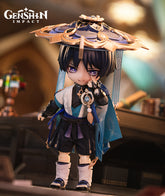



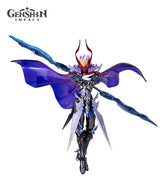
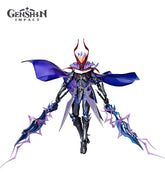






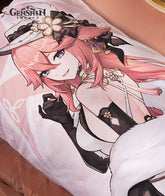



![[Official Merchandise] Tartaglia's Whale Monoceros Caeli Plush Keychain](http://genshinfans.com/cdn/shop/files/ZT01_58638da3-e310-49d5-a88c-13041871c325_165x.jpg?v=1692853712)
![[Official Merchandise] Tartaglia's Whale Monoceros Caeli Plush Keychain](http://genshinfans.com/cdn/shop/files/ZT02_9b45be1d-04a3-425b-8876-ef77131c49b5_165x.jpg?v=1692853713)
![[Official Merchandise] Tartaglia's Whale Monoceros Caeli Plushie Throw Pillow](http://genshinfans.com/cdn/shop/files/ZT01_2435f7d4-b203-44ed-acf0-64626d8e8a4f_165x.jpg?v=1692090445)
![[Official Merchandise] Tartaglia's Whale Monoceros Caeli Plushie Throw Pillow](http://genshinfans.com/cdn/shop/files/ZT02_c2e0ba02-cdf2-4b68-8cd7-7e98cfbdc415_165x.jpg?v=1692090446)




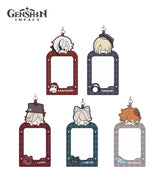

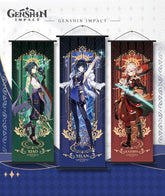
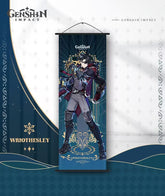
![[Official Merchandise] Genshin Impact Fatui Chibi Character Expression Sticker Badge](http://genshinfans.com/cdn/shop/files/ZT01_99ceacec-6f07-48a1-8ac8-d961dfeb2900_165x.jpg?v=1730526394)
![[Official Merchandise] Genshin Impact Fatui Chibi Character Expression Sticker Badge](http://genshinfans.com/cdn/shop/files/ZT02_d33473a2-2616-45da-a04f-946c6df0db8c_165x.jpg?v=1730526394)












